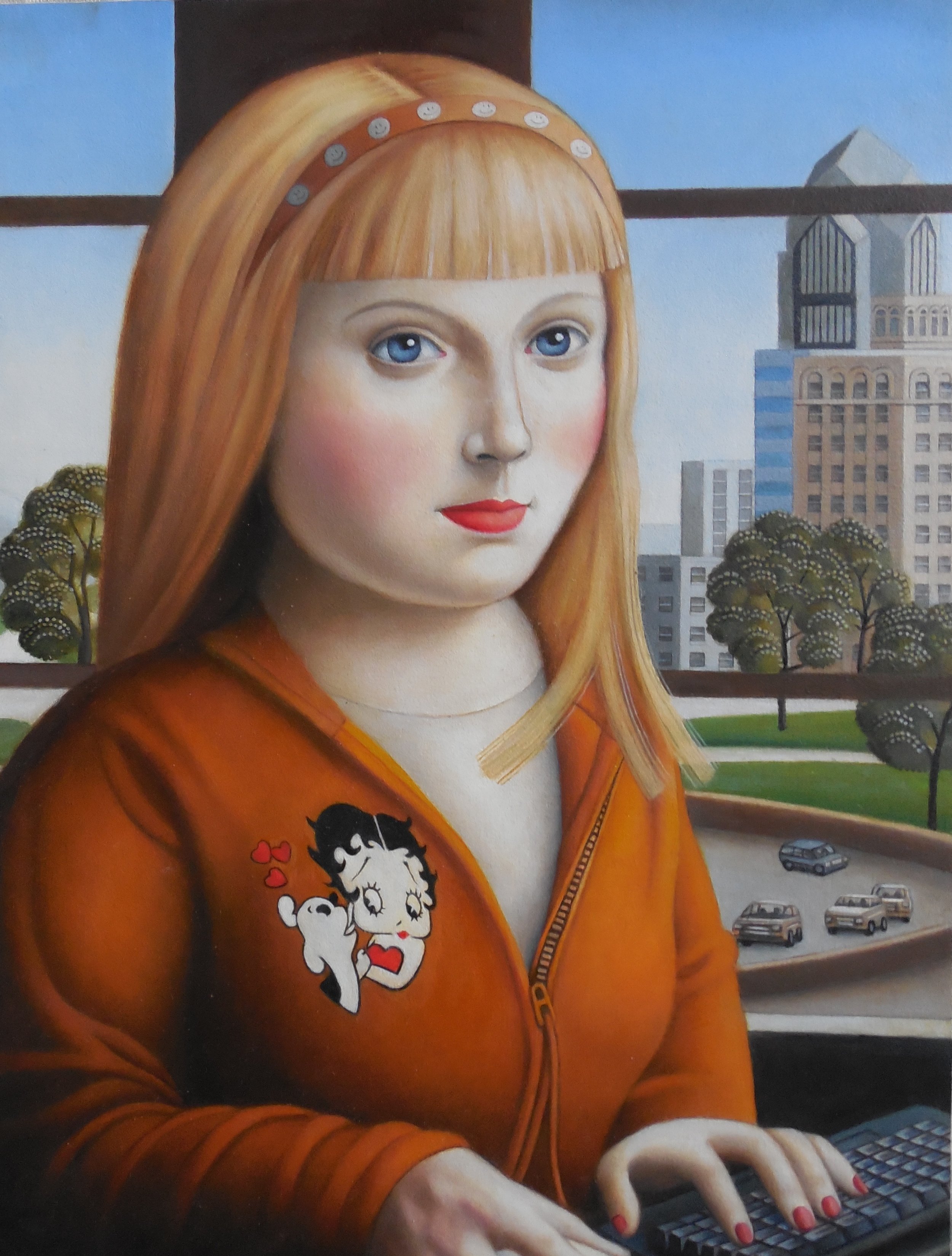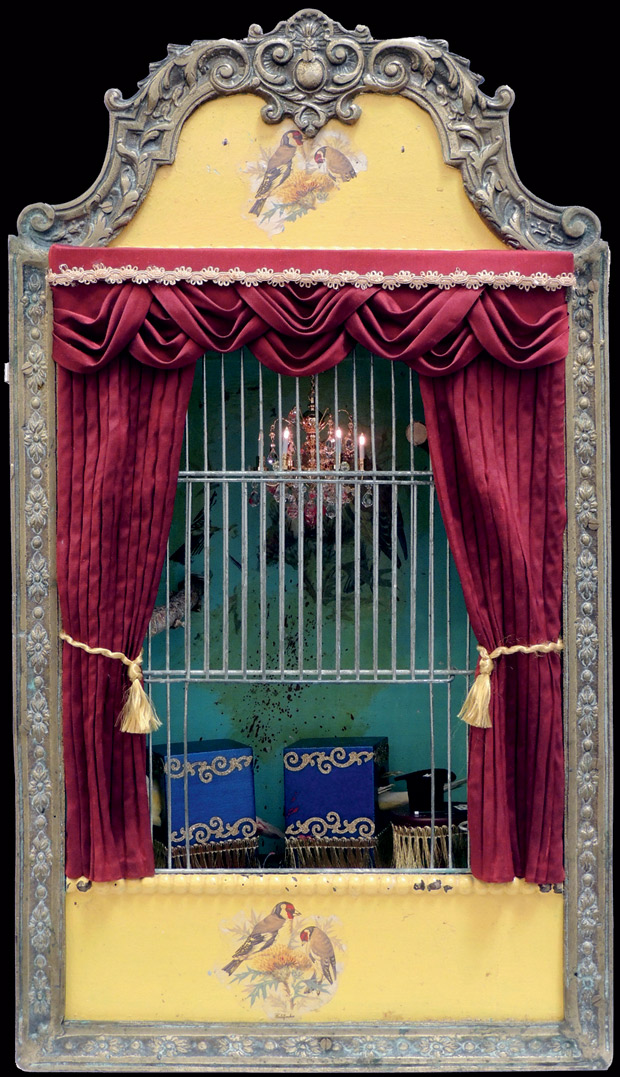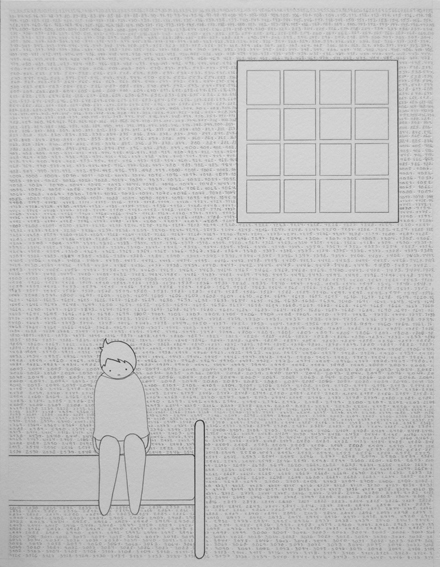An Artist's Work: Amy Hill
A gallery walk through with artist Amy Hill as she discusses her work piece-by-piece and her inspiration with Lois Lambert and Assistant Director, Maria Guerrero.
Maria: So you mean the original that you referenced?
Yes all of these reference a particular thing, each one. The artist referenced on this one is an unknown artist and he was originally holding ... something that was heart shaped, I can't remember what it was, like a card or something but I replaced it with a telephone or really a tablet, I think its too big to be a telephone.

Maria: Do you ever look into that particular painting's history, the towns it was made in or any other kind of information, does that ever influence you?
Yes. There are symbols that were uses doves and lilies were the biggest symbols they used... it was always something that indicated what they did for a living. So that one I mean actually if you google renaissance painting, you could find the original.
What is the building behind this one?
It's supposed to be a library or something but you know I just updated the original building from the original painting. It looked like a library to me. But the library doesn't really have to do with the tablet.
It doesn't have to.
Maria: Does it usually?
No
It's just about where the person happens to be?
Yeah, and there were columns, now a days we don't really have columns, but I think that libraries do and I like libraries.

Lois: And why the Betty Boop?
Betty Boop because my sweater had something on it, because she is a current phenomenon that people wear, you know logos instead of ruffles. And jewelry, we don't have a lot. We wear GAP clothing and sometimes on the GAP clothing is a little logo, its frustrating because we don't have that anymore.
This woman was holding the bible, and I put a more contemporary book. My neighbor posed for me and she was wearing a Tweetie Bird jacket and the head was taken from the original head.

Lois: Whats LA29?
That was on the original jacket
What contemporary book did you reference?
No particular book. Oh no it is the bible, You know when I was painting I was listening to the bible, an audio version of the bible and I got really into the bible.
Lois: How do you get that so small? (the print painted on the book)
You know what my eye sight is pretty bad right because of all my painting.
Maria: All the details?
I mean these are not the glasses I wear, I wear two glasses at one time. I put them on top of each other!
Maria: Is this a specific location, the shop front?
No, it isn't
Maria: But there is a reference to an espresso here...
Yeah, I think there may have been stores in the back.

Again, the original had a necklace but this is Michael Kohrs, and I hate to say it but people buy paintings with cats in them.
This is from a different painting totally by Han Memling, if you know him, but this is not a Memling character, it was taken from another painting, but this is the original jacket, I just liked it so much that I copied it even though its not really... and in the original she was wearing a striped shirt like that which I thought looked very contemporary. That's what really appeals to me about these paintings, is seeing what contemporary clothing we still have.
Which is funny because this starts to look like a vintage jacket, very contemporary for us to do...

I did that in one other painting, like this is a black jean jacket and I had a friend...I went over to her apartment and I said, just, you know pose for me with something, she picked up her camera and I loved the way the hands were, so I did it. This is made up. There's an original Memling painting, again Memling is the main source, the Memling painting had building but they weren't contemporary buildings. I just took buildings and made them look contemporary.
But its funny because I can easily say, oh, that looks like I'm off the freeway in Irvine, or something like that here in California. Like its a very similar landscape.

That's funny, I never even thought of doing that. Again this is the original sleeve, but this is a denim, I mean down vest that somebody posed for me, and again the buildings are more like apartment buildings. And her hair is exactly the same. I gave her a headband. And the face is the same.
She was looking down and I opened her eyes. One thing you can say about these paintings is that they never looked at the audience. They were always kind of looking inward, towards God. Toward him, like a prayer because they were all religious icons.
Because their gaze isn't directly at you it is almost like they're spacing out.

Right, but I like, he is wearing a walk man, so they are thinking about whats in the music. This again, my same friend, she had some pills so I had her pose with pills and there was like a tree here, and I turned it into McDonalds. And there was a church here and I just updated the church a little bit.

This one again a denim jacket because I think they are very decorative and metropolitan pin and do you recognize David Bowie and the hills are similar to the other hills.

This one was a nun and I love the background but I put more modern buildings, and I went to this punk celebration where I took pictures of punky people, this is what one of the girls was wearing with all this..[pointing at the pins]she had sex pistols and archie comics and this was when obama was running for president.
But the hair you changed...
Definitely, she had a nun thing on and one thing about the renaissance is that they were bad at ears, like there's hardly any ears in the whole renaissance. So you know, it was like covering the ears so I had to work on people's ears a lot.

This is almost exactly the head, I put him in a Ramones T-shirt, and then I put buildings in the background.

This is like Icebreakers chewing gum, I just like the logo, the graphic, she has updated buildings and updated earrings and her hair is different but the face is almost the same.

This is a Memling face with a new hair-do. I have models come over sometimes with hair. She was working at a store near me and I liked her look, so I invited her over and she had this kind of hair and this is a flash-drive that I had lying around. I was so mad that I had lost all the information on it. It died but I still had it lying around.
Like a commemoration...
Yeah. This is suburbia, I like suburbia, as an updated landscape.
This one I went to Macy's to find clothing and you can return at Macy's. So I bought this Ed Hardy thing and I just had some one pose in it and then I returned it. Because I love Ed Hardy. Even though hes not trendy now..
Hollister is so boring...Everything is boring now
This is from the original painting and I don't remember the name of the artist. And I drew in punky jewelry I add jewelry to everything And this is the east village were in the east village. Yeah I took this from google i mages.SHE NOT LOOKING AT THE CAMERA THISis more of the inner gaze.
THIS ONE I LOVE LOGOS. so I looked up what had the most logos and it was the NASCAR jackets and she had to be holding something contemporary.
You gave hera achase ard!...
So I gave her a chase card and she has an ear. She is also looking off into space. n
This was a prist and he had a priest head. THi sione is my bfs hair when it was shorter. This is a great ful dead t shirt. He was holding a flower originally [in the origianl painitng] and I kept because I felt like a hipie would be holding a flower.
These are anti-deppressents...Red Hot Chillie Peppers... and this is suberbia and this is not a Memling its some other artist that I really liked. this is a jacket that I own
And this is the gaze up as well but because shes listening to her music and this might be east vilalge in new york
I dont know do you hava nay questions
Yeah? One is how do you feel how these as a collection start to comment on popular culture?
Well its about materialism...I guess. Advertising with the use of the logos. Its about time travel. Its an anthropological study because I would love to go back in time and see if peaople look the same and are ther similarities? And alot of people think they are contemproary peaopl.
But theyre not theyre made up...theyr e like puzzle piees...
Rgiht but a ew of the faces are from that era and yet kyou caould down the street and spot someone like that.
Completely. The fact that use this bottle of anti-depressants or the bottle of Nature's Made vitamins.It s a commentary on what we do. but it also makes up an idenotity. Like this is gilr interrupted, with her anti-depressants and her hoodie sweater and her Red Hot Chillie Pepper shirt.
But I leave that to the viewer I dont want to dictate anything so you know I dont hink of that very often.
I think thats interdrting and the way tyou said it is best that its more of an anthropological observation on your part.
Right. That's the fun part of it. And just putting it al ltogether and seeing what happens. Not all of them are successful...
It's definitely not done in a vacuum and because it is valid data that you collect from your observations there are conclusions that we can draw from it for sure..
But there is also the aesthetics. I'm very concerned about how things look together. I use my computer a lot to re-adjust and play around. I want them to be pretty, too.
Well I remember when we spoke over the phone you spoke about how a lot of the draw to the t shirts and even people who specifically where more from an alternative subculture, because their clothing was just more interesting to paint. It was almost like a formal decision like "I just want to paint these figures".
Right. Right. Exactly. That's why I hate trends now. There is nothing exciting now. I dont wanto paint sweatshirts.
What will happen to your art if everyone is minimalistic clothing. What will happen to your art.
I've also done gothic people that was great and theyre not from the mainstream. Well you know even your shirt, I could paint that. Thre are still things thatwe wear today that I do love.
Great. Well thank you Amy.
Well good thank you.





 Catherine Coan was a huge hit at the 2016 L.A. Art Show in downtown Los Angeles -making it into many popular best of lists. A few years before she had made a huge splash as an Official Selection at the 2011 South by Southwest film festival with a short "The Canary Suicides" featuring her artwork. In 2012, the Canary Suicides was on display at the Lois Lambert Gallery. We are thrilled to welcome her back after such an amazing run at the L.A. Art Show and excited to showcase her new work.
Catherine Coan was a huge hit at the 2016 L.A. Art Show in downtown Los Angeles -making it into many popular best of lists. A few years before she had made a huge splash as an Official Selection at the 2011 South by Southwest film festival with a short "The Canary Suicides" featuring her artwork. In 2012, the Canary Suicides was on display at the Lois Lambert Gallery. We are thrilled to welcome her back after such an amazing run at the L.A. Art Show and excited to showcase her new work.


 the avant-garde work produced in Havana
the avant-garde work produced in Havana
 expect American art lovers to “stampede” to Cuba’s
studios and galleries as soon as it becomes easier
for them to travel and shop there. “I believe Cuban
art has been a best-kept secret among a few
collectors,” Mr. Farber said, “and now that Cuba is
opening up to us I think more people will discover a genre that’s fresh and great.”
expect American art lovers to “stampede” to Cuba’s
studios and galleries as soon as it becomes easier
for them to travel and shop there. “I believe Cuban
art has been a best-kept secret among a few
collectors,” Mr. Farber said, “and now that Cuba is
opening up to us I think more people will discover a genre that’s fresh and great.”
 Mr. Farber, who made his fortune as co-owner of
the Video Shack chain, sees parallels between the rebellious art made in China following the Tiananmen Square protests and art made during pivotal periods in Cuba’s revolutionary history. To gain access to Cuba’s art studios, he had to set up a charitable foundation five years ago and create an award for Cuban artists. Now, he owns more than 200 works and plans to go again next month.
Mr. Farber, who made his fortune as co-owner of
the Video Shack chain, sees parallels between the rebellious art made in China following the Tiananmen Square protests and art made during pivotal periods in Cuba’s revolutionary history. To gain access to Cuba’s art studios, he had to set up a charitable foundation five years ago and create an award for Cuban artists. Now, he owns more than 200 works and plans to go again next month.




